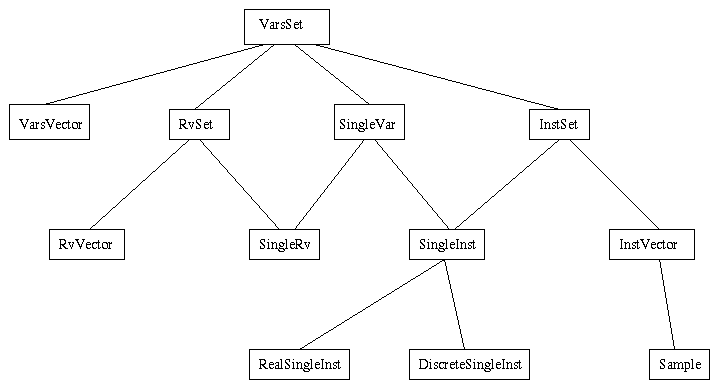Frog Tutorial
The Big Picture
Important Classes
| Simple Data Structures: several basic data structures have been implemented and used throughout the system, these include: |
| Vector: usually contains an ordered set of elements, the size of the vector increases automatically; | |
| Container: this class is used to store an unordered set of elements, these elements can only be accessed through an iterator; | |
| Graph: this contains both directed and undirected graphs, several standard graph manipulation algorithms have been implemented in this class; | |
| Random number generator: this can sample integers, reals and Gaussians. Creating several instances allows for independent generators to be run concurrently; | |
| Matrix: this class represents matrices and has some standard algorithms, such as matrix inversion; | |
| Hashtable; | |
| Heap. |
![]()
Design Decisions
Smart Pointers
Smart pointers are a method for implementing garbage collection
in C++. They encapsulate objects and contain a reference counter. This
counter records how many pointers refer to that object. If the counter
is zero, then the memory for that object is deallocated. This allows for
simpler coding and less worries about memory leaks.
For every class that can be smart pointed, there is a class file (suffix "_cl"), which contains the code for the class itself, and a smart pointer class (suffix "_sptr"). The smart pointer class contains a pointer to the class and an integer to maintain the reference count. All the standard operators are overloaded in the smart pointer class, including: =, -> and new.
For example, consider the class Name_cl, which contains a string, and the class Name_sptr which is a smart pointer to Name_cl. The following code is examplifies typical operations using smart pointers:
Name_sptr a,b;
b = new Name_cl("aaa");
a = b;
a->Print();
NOTE: a is a smart pointer object, it should not be deleted!
Now consider a subclass of Name_cl called Surname_cl, the following
code is valid:
Surname_sptr c;
...
a = c;
a->Print();
In this case, "a" is a superclass of "c", thus there are no problems
in the assignment. On the other hand, if we were trying to assign "a" to
"c", we would normaly have to typecast "a" when doing the assignment. With
smart pointers, we can't use a typecasting, because we don't have a reference
to the object. Thus, we must apply a conversion method:
c = Conv2Surname(a);
In general, there exists a method Conv2Type(...), for every
Type
of smart pointer.
Observations:
There are situations when smart pointers are unnecessary, for example,
nodes in a graph need not be smart pointed, as they will be removed when
the graph is deallocated.
When a method returns an object and you don't know if it is safe to
change this object, one way to check is to check there reference counter
on the smart pointer, if the value is one, then that is the only reference
to the object, so it must be OK to change it.
Some naming conventions:
| _cl - classes | |
| _sptr - smart pointers | |
| _ptr - standard pointers |
![]()
Random Variables
The figure below illustrates the hierarchy in different classes
for random variables.

A Random Variable, Rv, includes:
| id: this is an unique identifier for this variable; | |
| name; | |
| domain: this is used to differentiate between discrete and continuous variables. |
There are two important distinctions between classes in this hierarchy:
| Single versus Vector: Single describes a class that stores only one variable. Vector, on the other hand, uses the Vector class from simple data structures to store a collection of variables. | |
| Rv versus Instance: an Rv describes a random variable, while an instance is an Rv with an associated value. A Sample also includes a weight and a probability for that sample. |
Some important methods in VarsSet_cl are:
| GetNumberOfVars(void); | |
| GetJointDomainSize(void), this assumes that the variable is discrete; | |
| IsMember(SingleVar_cl var), the equality check is different for each type of variable. For Rvs, it checks if they are the same Rv. For Instances, it checks that the Rv and the Value are the same; | |
| IsPureDiscrete(void). |
| Methods for iterating through the set (NextInst(void), PrevInst(void), IsLegalValue(void), SetFirstValue(void), SetLastValue(void) and SetValue(int index1)). In the example below, the variables in the set are printed: |
Some additional methods in SingleInst_cl are:
| methods to set the value of this instantiation (SetValue(...)). |
![]()